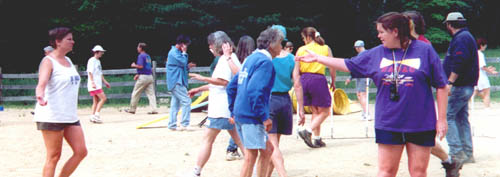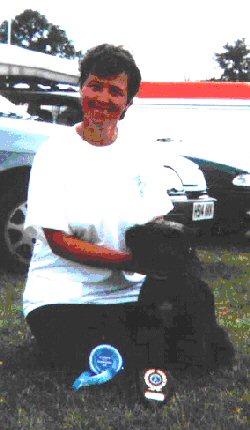Getting it right... revised

How often have you walked a
course and said ‘Well, this is too difficult’ or even ‘I'll just a blast round' with no thought
given? Let me tell you that it is very trickier than you think to set a course at just the
correct level to suit everyone in a class and to please the majority. Over the year you will
encounter a variety of types of courses e.g. flowing, handling etc. so, in the end, it means that
a greater number of people are catered for and everyone has had a chance run their ideal
course. Lin Bergan has revised and updated her 2004 article.
In my view, it is a
sad thing when young and inexperienced Grade 1 - 3 level dogs are faced with too many areas of
difficulty on a single course and consequently, make too many mistakes. Handler error accounts
for a lot of faults but, when a dog just cannot do something, it takes the joy out of the
round.
Obviously, as a
judge one must take the level of the course into account when setting a course and that's where
xxxxx starts.
A few unwritten
rules
In Grade 1, the generally accepted rule is that all the handling should be one side or
there should be only one or two easy changes. The course should be flowing with no tricks or
choices, meaning that is each obstacle should lead on easily to the next one.
In Grade 2, I think
that turns can be introduced with angles rather than curves in places to show that the handler
can control the dog and prove that the winner of the class has skills, not just speed. Bearing
in mind that a lot of the class will be first time dogs or dogs and handlers in their first
season, I would still aim at a level where the majority of the class can be successful. That
does not mean 100% clear rounds but that an element of success is achievable for all.
Going on to Grade 3
classes, the possibilities really widen out. In the last few years, I have seen Novice classes
change from 'up and down' to very complex, angled and quite difficult combinations. Personally
I feel that Novice courses should have one or two areas of difficulty but should also allow for
success on the whole. A handler and dog who miss a pull through or a sharper weave entry can,
at least, come off the course and say they only had 5 or 10 faults. The best dog on the day
will win!
There are a lot of
combinations which can be included at Novice level – slaloms, pull throughs, boxes, sharper
angles, call offs etc. but not all on the same course. I like to start either with a straight
part, put in some handling and then have a fast finish or begin with a handling section which
goes into a flowing section and finishes with a controlled section later on. This tests the
dog's ability to be controlled and to speed up as well as the handler's ability to understand
and work with the dog.
I remember at one
show I had to judge Grade 3 , Grades 1 to 7, and Grade 6 - all in the same ring - so I set a
course where no obstacles were moved, just some numbers. This was great fun to work out. I
always set out my courses on my training field and run them myself before the show. Recently I
have been lucky to have a variety of levels and sizes of dogs of my own to test the courses. I
also try them out on my club members, provided naturally that they are not entered at the show
in question!
Another thing which
may - or may not - be taken into consideration when setting a course is the rype of show
itself. If it is mainly a Starter show with just one Grade 3 class, for instance, most of the
competitors will probably be Starters. At a limit show, the winner will not graduate to a
higher class so the course again could be aimed towards a higher success rate. I usually feel
pleased if about 20% or more are clear and under 20% eliminated. Fewer clear rounds probably
means that the course is too difficult or that there are one or two problematic areas. More
eliminations means the same thing.
When I first started
judging a friend told me that the first 20 dogs were the worst and that still applies. What an
awful feeling it is when 19 dogs have run and there are still no clears. Thank goodness for dog
number 20.
An important factor
in working out a course is deciding where to stand and where to move around the course. I was
taught this skill by Dave Jolly on The Agility Club Judging course many years ago. This
especially applies on Agility courses as I am not the fastest mover and need to be able to see
those contacts when '‘Speedy Manic Dog' flies over the dogwalk and is gone. I do like to move
around when judging Jumping too, as standing in one place is more tiring, so I always plan my
route depending on tunnel entrances, weaves etc. and try not to get in anyone's way.
I believe that in
theory judges should have some experience and understanding of dogs of the height, type and
level they are judging and can get this either by running them in competition or by training
them. There are excellent all-round judges who have not progressed through the classes with
their own dogs and there are very successful handlers who have maybe forgotten what 'Starters'
really means.
Finally I read and
observe. I watch a lot of courses at shows and sometimes walk those I am not actually
running. There are a lot of good videos, web sites and magazines with a special interest in
course building including the American magazine Clean Run which has technical articles
about building and running sequences and examples of full courses.
I personally keep a
book with every course I have ever run or set and then some. I am waiting for the call to go on
Mastermind... specialist subject 'Agility Courses – The Last 25 Years.' Yes, I admit it. As a
pensioner, I am an Agility Anorak!
 About
the author... About
the author...
Lin Bergan has always had dogs, mostly Border Collies. She has trained dogs for obedience,
working trials and sheepdogs but has always enjoyed agility most.
Her first agility dog was a perpetual
starter, but she went on to get new puppies and rescue dogs and has had some success with them
in teams and in flyball. Her best dog to date has been Tip who is now 12 years old and retired.
She won out of Starters and into Senior and qualified for several national finals.
Millie, her mini dog is Advanced and
has qualified for Crufts in six separate events, coming third in the Mini/Maxi pairs in 2002
with Stuart Carter and Storm. She has been in almost every national Mini final and they have
been near the top of the Agility Club tables on several occasions, the best being second in
2002.
Gwen is a five year old WSD rescued dog
but she has hip displasia. She loves agility and is super fast but they often have jumps down
because of her disability.
She now has Todd (16 months) who will
start this year. He is the dog she has always wanted as he is not too wizzy and quite sensible…
unusual for her! She also has an eight month bitch called Trim who is related to Tip and is
just starting training.
Lin is a member of Mid Downs and
Tunbridge Wells clubs and trains at KIS agility, too. She also runs her own club, Sunniday which was sixth in the Premier Division of the Agility Voice tables in 2003.
Revised 15 September 2011
|